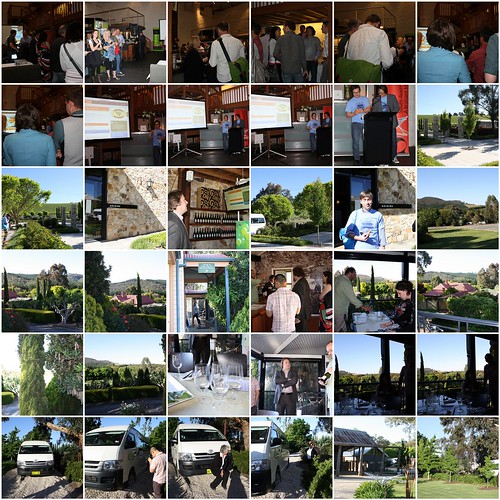A couple of weeks ago I received a mysterious invitation to the launch of the Qwoff Boys‘ next venture – complete with personalised link for RSVP and enigmatic clues. Earlier this year I’d very much enjoyed participating in their Semillon tweet-up from the Landmark Australia tutorial so I figured that even though information was scanty (Adelaide CBD, 2:30pm, Friday 19 November) it would be churlish not to attend.
After RSVPing clues filtered through during the week preceding the big day … attendees needed to meet at the Franklin St bus station, we needed to have our social media skills at the ready (I suspect Adelaide had not seen a greater collection of iDevices and other smart bits and pieces prior to this) and, finally, that our first stop would be Petaluma’s Bridgewater Mill.
So 2:30 Friday arrives and the 60 odd invitees pile themselves in to Des’s minibuses and head off out of Adelaide for the launch of the Great South Australian Wine Adventure.
Now, I’m a teensy tiny bit over the social network thing … some of it I find valuable, some annoying but necessary and some a really irritating duplication of several other networks. So I take some impressing. But impressed I am because in the Great South Australian Wine Adventure, the Qwoff Boys, in conjunction with the South Australian Tourism Commission, have come up with a promotional tool for the South Australian wine regions which is genuinely useful for both locals and visitors.
At present, only the Adelaide Hills region is live (the Barossa is going live on Friday) but this gives you a good idea of what the site will eventually offer for all our great wine regions. There’s the usual ‘useful’ stuff – like a listing of cellar doors and an events listing but (and this is the bit I really like) there’s also a selection of ‘trips’ for each region. The trips cover a handful of cellar doors (that are close to each other!) and at each cellar door visitors can check in and, potentially, earn rewards (for example, today, you receive a glass of The Local Sav Blanc if you check in at Golding Wines). If you check in at all the cellar doors on a trip you unlock a badge and (of course) there are also prizes to be won.
The trips are a real bonus – if you’ve ever found yourself entertaining guests from overseas or interstate, visiting wine regions (especially spontaneously) can be tricky. I find that the wineries I like are widely scattered and we spend more time driving around than wine tasting and we always end up missing lunch. The Great South Australian Wine Adventure allows you to look like you’re vaguely organised. And if you’re not in to the whole social media thing, there’s no requirement to check in.
That’s the idea behind the Great South Australian Wine Adventure and, like all good launches, we got to try the idea out for real … jumping back in the bus and heading off on one of the trips. My bus took us on Northern Exposure.
We started at Golding Wines where we enjoyed a few of their wines along with some tasting platters. Of special note was their sparkling (sensational value at something like $18 a bottle) and their Francis John Pinot Noir. Next we headed to Chain of Ponds, where we were spoilt with more food and wine: their little beef pies were amazing and this is definitely a winery I’ll be heading back to for lunch at some point. And we finished up at Barristers’ Block, where the wines had been matched with cheeses from Woodside Cheese Wrights.
At each winery staff went out of their way to accommodate us and make us feel welcome and I think everyone involved in the launch should feel well and truly chuffed: it was a great day.
And I can’t wait to try out the Barossa trips!

